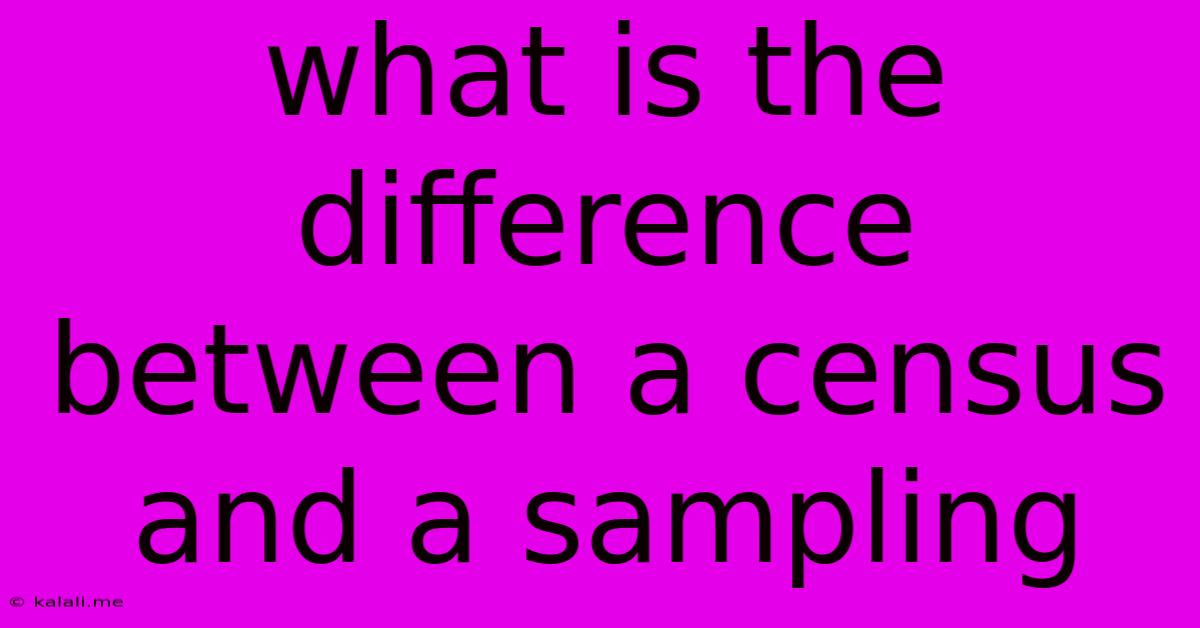What Is The Difference Between A Census And A Sampling
Kalali
Jun 12, 2025 · 3 min read

Table of Contents
Census vs. Sampling: Understanding the Differences in Data Collection
Collecting data is crucial for informed decision-making in various fields, from government policy to market research. Two primary methods for gathering this data are censuses and sampling. While both aim to understand a population, they differ significantly in their approach, scope, and the type of information they yield. This article delves into the core distinctions between these two vital data collection techniques. Understanding these differences is key to choosing the right method for your specific needs.
What is a Census?
A census is a complete enumeration of an entire population. It involves collecting data from every single member of the defined population. This comprehensive approach aims to provide a completely accurate picture of the population's characteristics at a specific point in time. Think of the decennial census conducted by many national governments – it aims to count every citizen within the country's borders.
Key characteristics of a census:
- Complete enumeration: Data is collected from every individual or unit within the defined population.
- High accuracy (theoretically): If executed perfectly, a census provides highly accurate data reflecting the entire population.
- Time-consuming and expensive: The exhaustive nature of a census makes it a lengthy and costly undertaking.
- Resource-intensive: Requires significant manpower, resources, and infrastructure to manage the data collection and processing.
- Potential for response bias: Even though aiming for complete coverage, some individuals may be missed or refuse to participate, leading to undercoverage bias.
What is Sampling?
Sampling, on the other hand, involves selecting a subset of the population (a sample) and collecting data from only those selected members. The goal is to infer characteristics about the entire population based on the information gathered from this smaller, representative sample. This method is far more efficient and cost-effective than a census, making it suitable for various situations where a census is impractical.
Key characteristics of sampling:
- Partial enumeration: Data is collected from a subset of the population, not the entire population.
- Less expensive and time-efficient: Significantly reduces costs and time compared to a census.
- Prone to sampling error: Results obtained from a sample may not perfectly reflect the entire population due to inherent variability. Proper sampling techniques aim to minimize this error.
- Various sampling methods: Different sampling techniques exist (random sampling, stratified sampling, cluster sampling, etc.), each with its own strengths and weaknesses. The choice of method depends on the research question and population characteristics.
- Statistical inference: Statistical methods are used to generalize findings from the sample to the larger population.
Comparing Census and Sampling:
| Feature | Census | Sampling |
|---|---|---|
| Scope | Entire population | Subset of the population |
| Cost | High | Low |
| Time | Long | Short |
| Accuracy | High (theoretically) | Prone to sampling error |
| Complexity | High | Moderate to high (depending on method) |
| Data Detail | Can collect extensive data | May limit data collection to key variables |
| Applicability | Suitable for small populations or critical data needs | Suitable for large populations or limited resources |
When to Use Which Method?
The choice between a census and sampling depends on several factors:
- Population size: A census is feasible for smaller populations, while sampling is preferable for larger ones.
- Resource availability: If resources (time, money, personnel) are limited, sampling is the more practical choice.
- Data requirements: If highly accurate data on every individual is needed, a census is necessary. If less precise estimates are acceptable, sampling suffices.
- Data sensitivity: For sensitive topics, a census might lead to higher response rates due to increased confidence in anonymity.
In conclusion, censuses and sampling are both powerful data collection methods. The optimal choice hinges on carefully considering the research objectives, resource constraints, and the desired level of accuracy. Understanding the strengths and limitations of each method enables researchers and decision-makers to select the most appropriate approach for their specific needs.
Latest Posts
Latest Posts
-
How Is Culture Different From Society
Jun 13, 2025
-
The Place Where An Organism Lives
Jun 13, 2025
-
1 2 6 24 120
Jun 13, 2025
-
Which Of The Following Is Not A Personal Computer
Jun 13, 2025
-
Webcam Is Input Or Output Device
Jun 13, 2025
Related Post
Thank you for visiting our website which covers about What Is The Difference Between A Census And A Sampling . We hope the information provided has been useful to you. Feel free to contact us if you have any questions or need further assistance. See you next time and don't miss to bookmark.